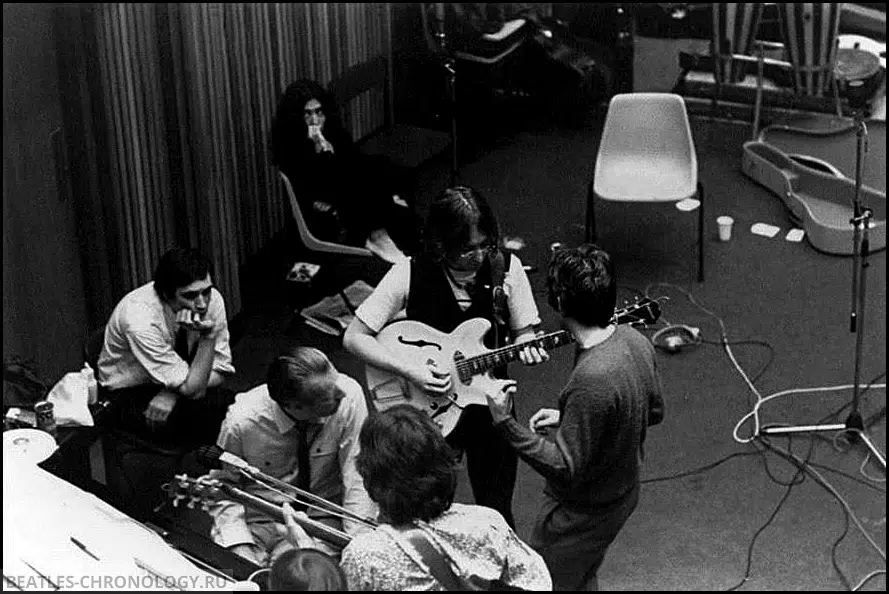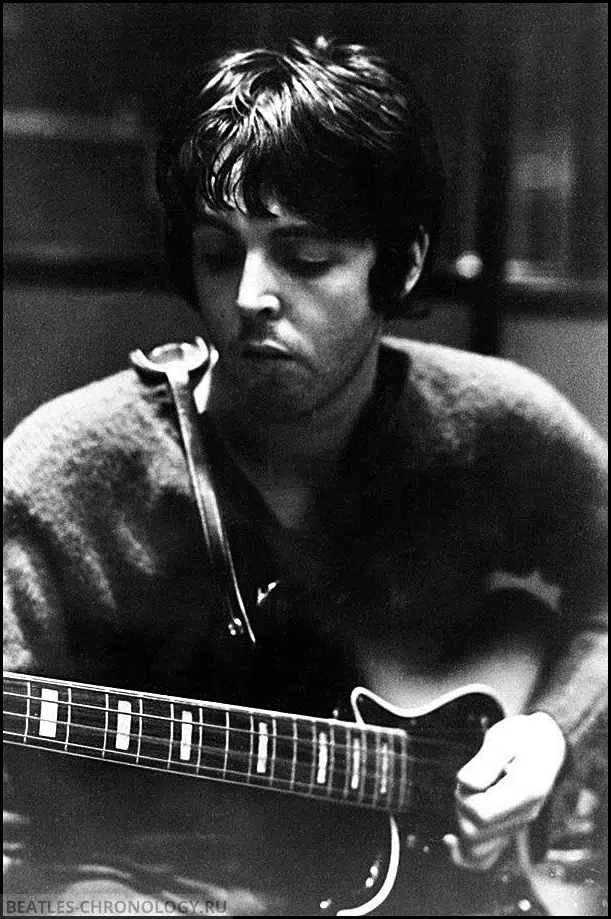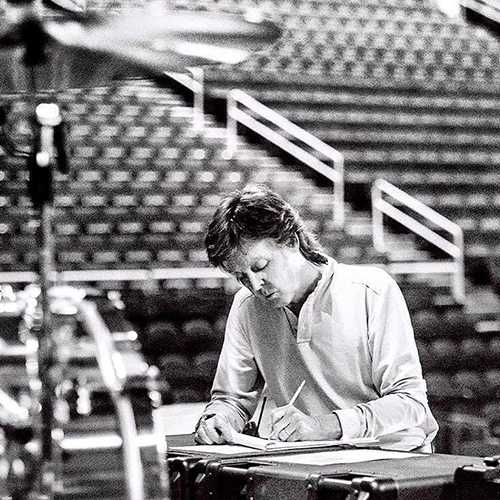"The Beatles" (aka the White Album) sessions
May 30 - Oct 18, 1968 • Songs recorded during this session appear on The Beatles (Mono)
Recording studio: Trident Studios, London, UK
Session Jul 30, 1968 • Recording and mixing "Hey Jude"
Article Jul 31, 1968 • The Apple shop in Baker Street closes down
Session Jul 31, 1968 • Recording "Hey Jude"
Article August 1968 ? • The Aerovons meet Paul McCartney at the Speakeasy
AlbumSome of the songs worked on during this session were first released on the "Hey Jude / Revolution" 7" Single
Following two days spent rehearsing and recording “Hey Jude,” The Beatles moved from Abbey Road to Trident Studios to take advantage of the eight-track recording capabilities there. Paul McCartney was familiar with Trident, having recently produced Mary Hopkin there, and George Harrison had also worked there with Jackie Lomax.
Such independent studios were setting up all over London. They were really trying to attract work and were installing new technology which was leaving the EMIs and Deccas a bit behind.
Ken Townsend – Engineer – From “The Complete Beatles Recording Sessions” by Mark Lewisohn, 1988
Then, on the Wednesday, we moved from EMI to Trident which is where the rest of the work was done on “Hey Jude”. In fact a fresh version of the number was started from scratch with George on electric guitar, Paul on piano and Ringo playing the tambourine. To the first backing tracks Paul added his solo vocal and then the others joined him to put on the harmony stuff.
Mal Evans – From The Beatles Monthly Book, September 1968, N°62
It turns out that EMI Studios had been in possession of an eight-track machine for about a year that none of us knew about because they were keeping it in a back room and tweaking it to get it up to EMI standards. But another studio, Trident Studios, did have an eight-track, and they had no such qualms—when the studio owners (the brothers Barry and Norman Sheffield) took delivery, they just opened the box, plugged in the machine, and went for it. That is one of the reasons I chose Trident to record James Taylor’s first album. Paul McCartney very kindly came over and visited one of our sessions, and he played bass for us on a song for that album called “Carolina in My Mind.” Paul realized then how cool it would be to work on eight-track and decided to bring all the Beatles over to try recording a song there. And that’s why they all came over to Trident to record “Hey Jude” in an eight-track format.
Peter Asher – From “The Beatles from A to Zed: An Alphabetical Mystery Tour“, 2019
The first task of the day was transferring Take 25, which had been recorded the previous day, from EMI’s four-track tape to Trident’s eight-track tape for additional overdubs. Ultimately, the decision was made to begin anew.
We eventually did get what turned out to be a master of the basic track consisting of Paul on piano, John on acoustic guitar, and Ringo on drums. However the next couple of days they were booked in at Trident Studios for the overdubs because they wanted to record on 8-track, and Trident was the first and only 8-track studio in London at that time. They ended up having problems transferring the 4-track master from EMI to the 8-track at Trident for some reason, so the band ended up recording another basic track and finishing the song at Trident. They also had to mix it there because, of course, Trident was the only studio in town with an 8-track tape machine.
Ken Scott – From “Abbey Road to Ziggy Stardust“, 2012
Four versions of the new rhythm track, labelled Takes 1 to 4, were recorded, featuring Paul McCartney on piano with guide vocals, John Lennon on acoustic guitar, George Harrison on electric guitar, and Ringo Starr on drums.
Take 1 was considered the best. Subsequently, overdubs were applied to Take 1, with Paul enhancing certain sections with more piano, George supplementing with additional guitar and Ringo adding some tambourine.
On this day, the phrase “She has found you now go and get her” was changed to “You have found her now go and get her.” Additionally, Paul recalls an amusing anecdote related to this session:
There is an amusing story about recording it. We were at Trident Studios in Soho, and Ringo walked out to go to the toilet and I hadn’t noticed. The toilet was only a few yards from his drum booth, but he’d gone past my back and I still thought he was in his drum booth. I started what was the actual take, and Hey Jude goes on for hours before the drums come in and while I was doing it I suddenly felt Ringo tiptoeing past my back rather quickly, trying to get to his drums. And just as he got to his drums, boom boom boom, his timing was absolutely impeccable. So I think when those things happen, you have a little laugh and a light bulb goes off in your head and you think, This is the take! And you put a little more into it. You think, oh, fuck! This has got to be the take, what just happened was so magic! So we did that and we made a pretty good record.
Paul McCartney – From “Paul McCartney: Many Years from Now” by Barry Miles, 1997
Engineer Geoff Emerick recounts another anecdote in his book “Here, There and Everywhere: My Life Recording the Music of The Beatles,” despite not being present at the session:
Just after the start of the third verse, right between the lines ‘The minute you let her under your skin / Oh, then you begin,’ you can clearly hear Paul curse off mic, saying ‘F#cking hell!’ (Engineer) John Smith had a vivid memory of John Lennon pointing that out when they were playing the tape back. ‘Paul hit a clunker on the piano and said a naughty word,’ Lennon gleefully crowed, ‘but I insisted we leave it in, buried just low enough so that it can barely be heard. Most people won’t ever spot it…but we’ll know it’s there.’ That was just the kind of sophomoric humor Lennon was into, but I have to admit it’s amusing to think that millions of fans have heard the record millions of times without ever realizing that it contains a dreaded four-letter word that was strictly taboo back in 1968.
Geoff Emerick – From “Here, There and Everywhere: My Life Recording the Music of The Beatles“, 2006
According to John Perry, of the band Grapefruit, this “Fucking hell!” was not said by Paul but by himself:
One notable evening, 30th July 1968 was spent in the studio in one of [The Beatles’] sessions for a change. To begin at the beginning, we had some free time and I was out carousing (as you do) in Wardour St. visiting the Ship pub, and later Jack Barry’s bar, which everybody did in those days. I hadn’t got to Jack’s Bar yet and I was sitting in the pub nursing a beer feeling pretty flat, with nothing going on, when suddenly I remembered that somebody had mentioned that ‘the Boys’ were going to be recording at Trident Studios in St Anne’s Court, just around the corner from the pub.
This seemed infinitely more interesting than what I was doing, so I went along and knocked on the door. It was opened by BIG Mal Evans The lovely Beatles roadie I’d met at IBC studios, who obviously knew me and said, “Hi John, the Boys are in here tonight d’ you wanna come in?” I was through that door before he could even blink.
It was here I watched the boys in action. It seemed that the piano and drums had been previously recorded as had the lead vocal, I’m pretty sure including the screaming ad libs on the end. So I witnessed John and George tracking on those lead guitar bits in the control room, watched Paul add his bass line, in the large downstairs room, which was phenomenal. I had always been a great admirer of Paul’s bass lines, they were almost songs in themselves having a melody and a groove that really fit whatever song he was working on. After this the Boys came around the Neumann mic setup in the middle of the floor of the big downstairs room and started adding the 3 part (drifters type) harmonies. All’s great and I’m very happy watching all this,’til they came to the part of the song that goes, ‘better, better, better, AAAAH’. I was by this time sitting on the floor just watching this film-like event unfold before me with the 4 Beatles around the mike singing various bits when the track got to the middle of the verse prior to the Better, better, bit. Paul, suddenly looks over in my direction and ushers me over to join them.
I look around to see who he’s talking to, and seeing only a wall concluded quite brightly that he must be talking to me. I get up and start to walk towards the mic (which J, P, G and R are standing around) – the track is still recording. Paul once again gestures at some headphones lying on the floor. I reach down and put them on, they are SO LOUD that I shout out ‘f**king hell’ (to my eternal shame or glory depending on your standpoint!). I then (nervously) sang along with the Beatles, the first layer of na-na-na’s (after the better better part) going right to the end of the song.
You know I can hardly believe I was there myself but I guess the proof that I was, unless Paul or Ringo can confirm, is that my expletive (undeleted) can still be heard on the record at about 2.59 where the line ‘Remember to let her under your skin, Then you begin, to make it better, better better, AAAH!’ under the word ‘BEGIN’. It’s clearly not a Liverpudlian accent – and as I was the only cockney in there…
John Perry – From grapefruit-booklet-uncorrected-CopyTHIS-ONE.pdf (heartrecords.org)
The Beatles returned to Trident Studios the following day to complete the recording of “Hey Jude“.




Recording • Remake - Take 1
Recording • Remake - Take 2
Recording • Remake - Take 3
Recording • Remake - Take 4
Recording • SI onto take 1
The Complete Beatles Recording Sessions • Mark Lewisohn
The definitive guide for every Beatles recording sessions from 1962 to 1970.
We owe a lot to Mark Lewisohn for the creation of those session pages, but you really have to buy this book to get all the details - the number of takes for each song, who contributed what, a description of the context and how each session went, various photographies... And an introductory interview with Paul McCartney!
The Beatles Recording Reference Manual: Volume 4: The Beatles through Yellow Submarine (1968 - early 1969)
The fourth book of this critically acclaimed series, "The Beatles Recording Reference Manual: Volume 4: The Beatles through Yellow Submarine (1968 - early 1969)" captures The Beatles as they take the lessons of Sgt. Pepper forward with an ambitious double-album that is equally innovative and progressive. From the first take to the final remix, discover the making of the greatest recordings of all time. Through extensive, fully-documented research, these books fill an important gap left by all other Beatles books published to date and provide a unique view into the recordings of the world's most successful pop music act.
If we modestly consider the Paul McCartney Project to be the premier online resource for all things Paul McCartney, it is undeniable that The Beatles Bible stands as the definitive online site dedicated to the Beatles. While there is some overlap in content between the two sites, they differ significantly in their approach.

Notice any inaccuracies on this page? Have additional insights or ideas for new content? Or just want to share your thoughts? We value your feedback! Please use the form below to get in touch with us.